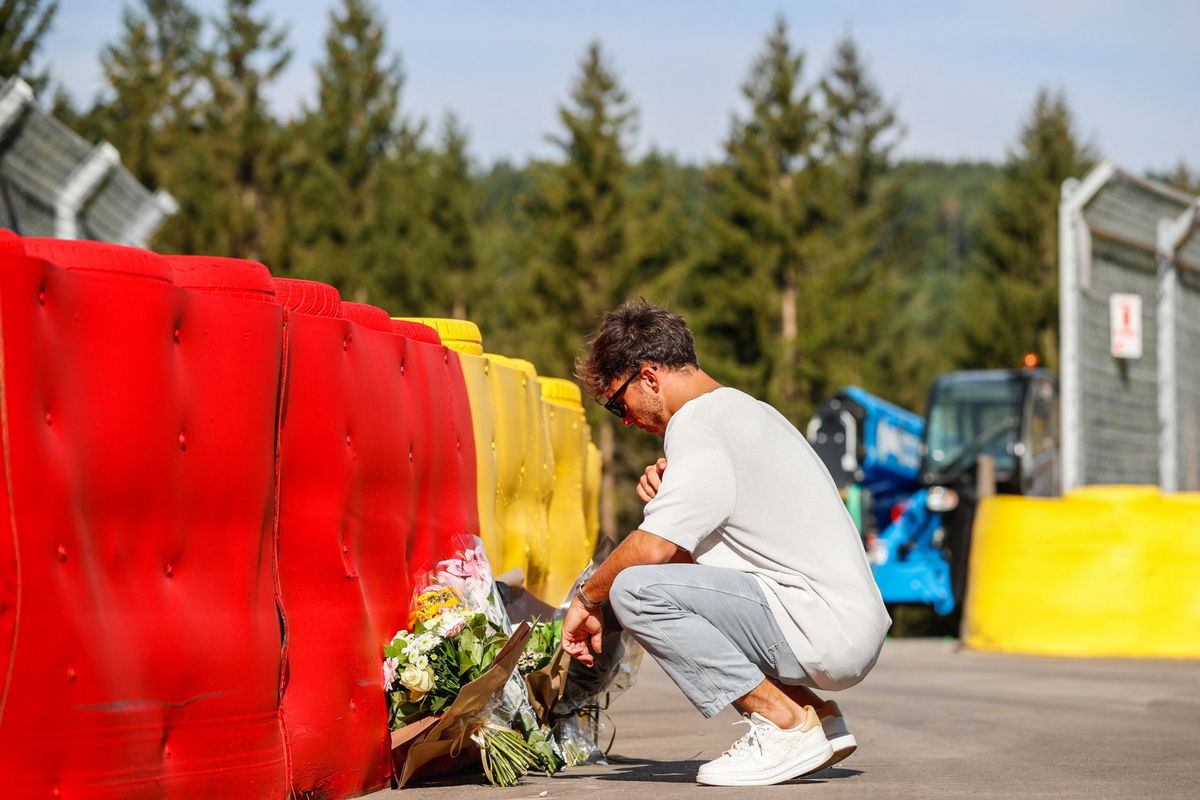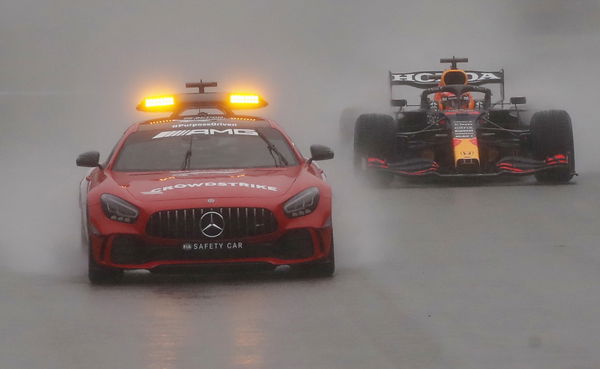
Imago
GASLY Pierre fra, Scuderia AlphaTauri AT03, portrait bringing flowers in the Raidillon in memory of Anthoine Hubert during the Formula 1 Rolex Belgian Grand Prix 2022, 14th round of the 2022 FIA Formula One World Championship, WM, Weltmeisterschaft from August 26 to 28, 2022 on the Circuit de Spa-Francorchamps, in Francorchamps, Belgium – F1 – BELGIAN GRAND PRIX 2022 DPPI/Panoramic PUBLICATIONxNOTxINxFRAxITAxBEL 00122033__V2_8492

Imago
GASLY Pierre fra, Scuderia AlphaTauri AT03, portrait bringing flowers in the Raidillon in memory of Anthoine Hubert during the Formula 1 Rolex Belgian Grand Prix 2022, 14th round of the 2022 FIA Formula One World Championship, WM, Weltmeisterschaft from August 26 to 28, 2022 on the Circuit de Spa-Francorchamps, in Francorchamps, Belgium – F1 – BELGIAN GRAND PRIX 2022 DPPI/Panoramic PUBLICATIONxNOTxINxFRAxITAxBEL 00122033__V2_8492
“It’s just too dangerous” – Max Verstappen said about racing at Spa in the rain. The three-time World Champion was not all wrong, since there is a spine-chilling history behind the historic Circuit de Spa-Francorchamps! The 7-kilometer circuit that covers the lush green Belgian hills is as spectacular as it is challenging. The rich heritage of Spa might deceive you just like its iconic corners and turns have deceived many racers to cause heart-stopping accidents. And among these corners, Eau Rouge remains the most attractive (and deadly) one. But the challenge of the Eau Rouge is not the only one that awaits F1 drivers who are going to take part in the Belgian Grand Prix this weekend. There are several other corners too–like the Blanchimant, Puchon, and La Source.
Watch What’s Trending Now!
To the common English speaker, the names of the Spa-Francorchamps turns might sound like a mouthful. But each of their names has a vast history behind it. Before delving into that, we must tell you all about the legacy of the Spa circuit. The year was 1925–exactly 99 years ago–when the race track hosted its first Formula 1 Grand Prix. Thus, its history stretches to the pre-World War II times when F1 was very, very different from what it is today. Since then, the Spa-Francorchamps has undergone many reconstructions. In 1979, it had the biggest restructuring as the authorities shortened the 14 km track in the face of safety concerns.
Now, the Spa-Francorchamps circuit is a Mecca for all motorsports lovers as it hosts WEC and MotoGP races too. But because of its difficult route, it has seen some heart-wrenching fatalities that silenced the entire sports community. One of the most famous high-profile incidents happened when F2 racer Anthoine Hubert lost his life in a multi-car crash ahead of the 2019 Belgian GP. Meanwhile, this race track has also seen some of the most valuable F1 moments unfold as Hubert’s friend Charles Leclerc won the 2019 Belgian GP and dedicated his fantasy story-like win to Hubert in a heartbreaking moment.
ADVERTISEMENT

ADVERTISEMENT

Reuters
Formula One F1 – Belgian Grand Prix – Spa-Francorchamps, Spa, Belgium – August 29, 2021 General view of the safety car followed by Red Bull’s Max Verstappen REUTERS/Christian Hartmann
By now, you must have understood why the Spa track and its Eau Rouge corner are so special to the racing community. Thus, let’s get into the details of how this turn got its name.
ADVERTISEMENT
Eau Rouge was a product of the circuit owners’ competition
Ever since the start of the Belgian GP, racers have faced challenges steering through the Eau Rouge and the Radillion. Now, you might ask: are these two different parts of the Spa track? Well, the interesting thing is some sources say the Eau Rouge is an iconic corner that leads to the Kemmel Straight, and its actual name is ‘Radillion on the Eau Rouge’. According to the website ‘Circuits of the Past’, the name of this corner has come up in a strange way.
ADVERTISEMENT

The story goes that the 1930s saw several racing circuit owners compete amongst themselves to decide who could construct the fastest tracks. At that time, the Spa owners decided to install an artificial turn that would have an elevation of 134 ft (40.8 m). Now, the turn came to be known as the ‘Eau Rouge’. But as per ‘Circuits of the Past’, Radillion is the new steep fast right-hander built on the ashes of the old Eau Rouge corner, cutting off the l’Acienne Douane section.
ADVERTISEMENT
Now, right in front of the Radillion, there is a brook called Eau Rouge. The name has stuck to it because of the reddish color of its water (‘rouge’ is red in French) since it has high iron content. So, some people call the Radillion as Eau Rouge even though the official Spa-Francorchamps website says: “The removal of the old Customs bend and the construction of a spectacular curve which was baptised the Raidillon, more often called the Eau Rouge bend by foreigners.”
Top Stories
Language Barrier Didn’t Hold Back Lando Norris to “Hook Up” With OnlyFans Model: “We Talked by Mime”

Oscar Piastri Heads for Painful Surgery After Finishing Rookie Season on a High

Brad Pitt’s “Ego” Crushed to Bits After $140,000,000 Venture Backed by Lewis Hamilton Poses Serious Challenges

Breaking Down Rebecca Donaldson’s Jaw Dropping Dating History: From Kardashian Debut to Dating F1 Star

Little Fan Makes “Super Important” Charles Leclerc Wish With a Promise to See Him at the Italian GP

Well, now that you have learned the story behind Eau Rouge and the curious case of its nomenclature, there’s another question that might be on your mind: what makes Eau Rouge a deadly affair?
ADVERTISEMENT
The story behind Eau Rouge’s rise as a villain in motorsports
As a world-famous corner that fans love to keep an eye out for, Eau Rouge has earned its name in motorsports. But it has also earned the reputation of a villain for claiming the lives of some bright talents in the racing world. One of them, of course, is Anthoine Hubert. Right after the start of the 2019 F2 Feature Race, Trident racer Guiliano Alesi lost control of his car while steering through Eau Rouge. Then, Alesi’s teammate Ralph Boschung saw him and steered towards the right, slowing down to avoid the debris. And hurtling after Boschung, there was Hubert who could not see the car ahead of him.

Imago
2019 Paul Ricard CIRCUIT PAUL RICARD, FRANCE – JUNE 23: Anthoine Hubert (FRA, BWT ARDEN) during the Paul Ricard at Circuit Paul Ricard on June 23, 2019 in Circuit Paul Ricard, France. (Photo by Joe Portlock / LAT Images) Images) PUBLICATIONxINxGERxSUIxAUTxHUNxONLY _R3I3220
As Hubert crashed into the tire barrier, the side wall deflected him and sent him on the path of Juan Manuel Correa. Correa hit the left side of Hubert’s car and it was 90 minutes later that physicians pronounced the death of Anthoine Hubert. More recently, in 2023, Formula Regional European Championship racer Dilano Van’t Hoff lost his life in Spa too. He was only 18 when he got into a multi-car crash in heavy rain at the exit of the Eau Rouge/Radillion curve.
ADVERTISEMENT
With the bloody history that tails the Eau Rouge, every fan can now realize how tough the challenge of the Belgian GP is for all racers. So, which racer do you want to see at the front of the pack at the upcoming Belgian GP? Share your thoughts in the comments below.
ADVERTISEMENT
ADVERTISEMENT
ADVERTISEMENT

